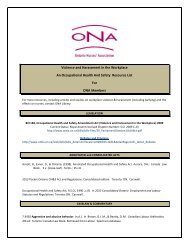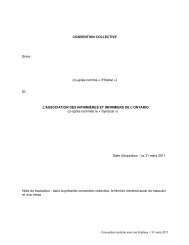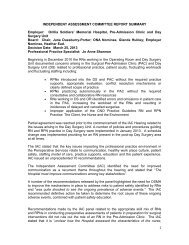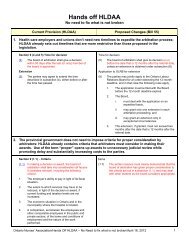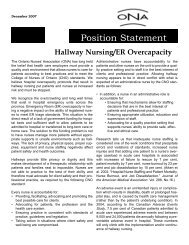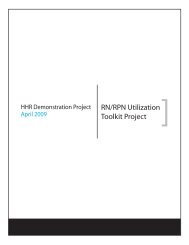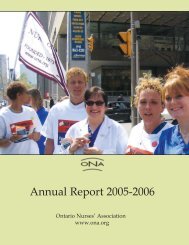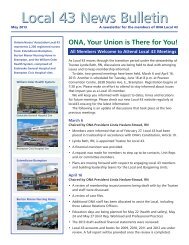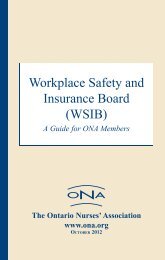RN and RPN Environment Professional Practice Teleconnect
RN and RPN Environment Professional Practice Teleconnect
RN and RPN Environment Professional Practice Teleconnect
You also want an ePaper? Increase the reach of your titles
YUMPU automatically turns print PDFs into web optimized ePapers that Google loves.
12<br />
<strong>Practice</strong> Guideline<br />
Appendix<br />
Quality <strong>Practice</strong> Settings<br />
A quality practice setting is a workplace that<br />
supports nursing practice, fosters professional<br />
development <strong>and</strong> promotes the delivery of<br />
quality care. As partners in the effort to achieve<br />
quality care, nurses <strong>and</strong> employers have a shared<br />
responsibility to create practice environments that<br />
support competent nurses in providing quality<br />
outcomes for clients. To create quality practice<br />
settings that support effective utilization of nurses,<br />
the College encourages employers <strong>and</strong> nurses to<br />
consider incorporating the following strategies.<br />
Care delivery processes<br />
These factors support the delivery of nursing care/<br />
services <strong>and</strong> include the care/program delivery<br />
model, staffing ratios <strong>and</strong> staffing mix, st<strong>and</strong>ards<br />
of care, accountability <strong>and</strong> ongoing quality<br />
improvement measures. There is a growing body<br />
of research about the link between staff mix <strong>and</strong><br />
nursing-sensitive client outcomes. This research<br />
points to the need for decision-makers to consider<br />
the appropriate utilization of <strong>RN</strong>s <strong>and</strong> <strong>RPN</strong>s in<br />
the practice setting. An appropriate mix is key to<br />
providing quality care.<br />
Possible strategies include:<br />
■<br />
an evidence-based nursing care delivery model<br />
that takes into consideration relevant best<br />
practices, client complexity <strong>and</strong> the practice<br />
expectations for the typical nurse, <strong>and</strong> facilitates<br />
quality nursing practices<br />
■<br />
considering client complexity, staffing mix <strong>and</strong><br />
ratios, <strong>and</strong> the nurses’ roles in coordinating<br />
resources when addressing staffing issues<br />
■<br />
clear accountability to ensure support for nurses<br />
who report gaps between their individual<br />
competencies (practice limitations) <strong>and</strong> practice<br />
expectations<br />
■<br />
a continual quality improvement process, led by<br />
nurses in collaboration with other members of the<br />
team, to facilitate regular review of nursing roles<br />
<strong>and</strong> expectations.<br />
Communication systems<br />
These systems support the sharing of information<br />
<strong>and</strong> decisions about client care <strong>and</strong> services.<br />
Factors affecting the quality of communication<br />
systems include communication with clients <strong>and</strong><br />
families, professional communications, information<br />
systems <strong>and</strong> technology, communication within<br />
<strong>and</strong> between programs, <strong>and</strong> conflict resolution<br />
mechanisms.<br />
Possible strategies include:<br />
■<br />
developing mechanisms ensuring that major<br />
changes to nursing roles <strong>and</strong> practice expectations<br />
are communicated in a timely manner<br />
■<br />
engaging nurses in discussions regarding current<br />
or changing roles <strong>and</strong> practice expectations within<br />
the organization<br />
■<br />
creating communication systems that promote<br />
<strong>and</strong> support the exchange of information between<br />
<strong>RN</strong> or <strong>RPN</strong>s <strong>and</strong> the health care team to<br />
facilitate the delivery of quality client care.<br />
Leadership<br />
Leadership occurs at all levels within an<br />
organization. It is the process of supporting others<br />
to improve client care <strong>and</strong> services by promoting<br />
professional practice. Effective leadership is<br />
demonstrated by staff participation in decisionmaking,<br />
the philosophy of the organization <strong>and</strong> the<br />
style of individual leaders within the organization.<br />
Possible strategies include:<br />
■<br />
developing a nursing governance structure to<br />
address all nursing practice issues<br />
■<br />
providing opportunities for nurses to enhance<br />
their individual leadership skills within a defined<br />
role<br />
■<br />
creating mechanisms to help nurses manage<br />
professional role conflict effectively, as it arises, on<br />
a one-to-one <strong>and</strong> collective basis.<br />
Organizational supports<br />
Organizations support the delivery of client care,<br />
services <strong>and</strong> programs through their policies,<br />
procedures, norms <strong>and</strong> values. Organizational<br />
supports include the organization’s philosophy,<br />
policies <strong>and</strong> procedures, health <strong>and</strong> safety<br />
requirements, <strong>and</strong> recruitment <strong>and</strong> retention<br />
strategies.<br />
College of Nurses of Ontario <strong>Practice</strong> Guideline: <strong>RN</strong> <strong>and</strong> <strong>RPN</strong> practice: The Client, the Nurse <strong>and</strong> the <strong>Environment</strong>



